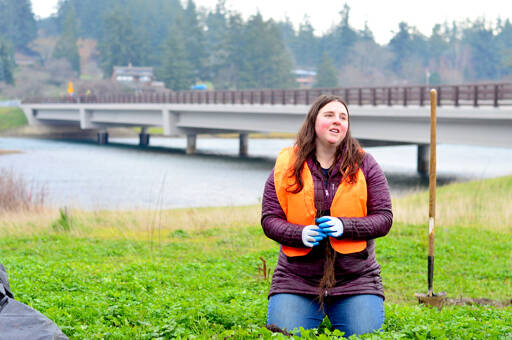MARROWSTONE ISLAND — On tree-planting day, Sarah Doyle, Kevin Long and Rebecca Benjamin don’t just hand out shovels. Instead, one rainy, windy day in late December, these North Olympic Salmon Coalition leaders first brought everyone together on the beach to paint the full picture.
Until the mid-20th century, young salmon swam freely from Oak Bay into food-rich Kilisut Harbor, the body of water between Indian and Marrowstone islands.
When the causeway was installed in the 1940s, said Long, the North Olympic Salmon Coalition (NOSC) senior project manager, “it caused the whole channel to plug up.”
That meant strangled tidal movement and an environment inhospitable to fish.
Enter NOSC, the state Department of Transportation, the U.S. Navy and people on Marrowstone Island. These partners got together on a giant restoration project: the removal of the causeway and the building of the 440-foot Kilisut Harbor bridge.
“We opened the channel in August 2020 and finished in October 2020,” Long said of the project.
Around it are 27 acres of marine intertidal habitat and tidal-fringe salt marsh: wide open for wildlife and the backdrop for a tree planting.
About two dozen volunteers turned out on a cold Wednesday morning — three days before the first big snowstorm of winter — to put 600 sets of roots into the ground.
That’s small compared with some that NOSC does, said Doyle, the coalition’s program and partnership manager. Other plantings across the North Olympic Peninsula have involved 2,000 to 3,000.
With the bridge behind her, Doyle demonstrated how to plant bare-root shrubs: red flowering currant, ocean spray, serviceberry and snowberry among them.
Some Douglas firs would also be planted on the Navy’s Indian Island property, she noted.
As plants grow up and out, they restore the natural balance of things, stabilizing banks and dropping insects into the water — food for juvenile salmon, said Benjamin, NOSC executive director.
The volunteers at this tree planting ranged in age from Charles Espy, an elder who photographs the work, to Oliver Scheibl, 6, who came with his father, Chris Scheibl.
“People are really interested in this [Kilisut] project,” said Benjamin, adding she limited the volunteers to 30 for the sake of site management.
She marveled at Marrowstone Islanders’ cooperative spirit during the lengthy bridge project. Construction affected residents for more than a year, Benjamin said, yet motorists waved and said hello to construction crews, “which is not normal.”
The bridge installation “was driven by a community group. Our nonprofit [NOSC] was the driver of this project,” she added.
The coalition strove to keep islanders informed all the way through, which is different from having the Department of Transportation suddenly show up and start construction, Benjamin said.
Over the past year, NOSC also has planted trees and shrubs along the Dungeness and Pysht rivers in Clallam County and around Chimacum Creek and the Snow Creek estuary in East Jefferson County. Another planting was done at Kilisut Harbor in early 2021.
The restoration around Marrowstone Island benefits not only young salmon, but also birdlife, shellfish and eelgrass. Greater Kilisut Harbor and Oak Bay, identified as Important Bird Areas by the Washington Audubon Society, support up to 13,500 wintering shorebirds and waterfowl.
The snowfall from Christmas through New Year’s Day was unlikely to hurt the newly planted trees and shrubs, Doyle said Tuesday.
“We plant bare-root stock during the winter months since the plants are dormant and it provides the roots an opportunity to get well-established in their new home. In doing this, we are doing our best to reduce the stress on the plants,” she said, noting these are hardy, native species.
NOSC will check on them come spring, Doyle added, and plant more, if needed.
________
Jefferson County senior reporter Diane Urbani de la Paz can be reached at 360-417-3509 or durbanidelapaz@peninsuladailynews.com.

